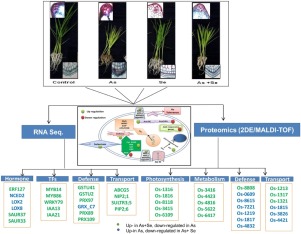当前位置:
X-MOL 学术
›
J. Hazard. Mater.
›
论文详情
Our official English website, www.x-mol.net, welcomes your
feedback! (Note: you will need to create a separate account there.)
Transcriptome and proteome analyses reveal selenium mediated amelioration of arsenic toxicity in rice (Oryza sativa L.).
Journal of Hazardous Materials ( IF 12.2 ) Pub Date : 2020-01-16 , DOI: 10.1016/j.jhazmat.2020.122122 Reshu Chauhan 1 , Surabhi Awasthi 2 , Yuvraj Indoliya 3 , Abhishek Singh Chauhan 3 , Shashank Mishra 4 , Lalit Agrawal 5 , Sudhakar Srivastava 6 , Sanjay Dwivedi 3 , Poonam C Singh 3 , Shekhar Mallick 3 , Puneet Singh Chauhan 3 , Veena Pande 7 , Debasis Chakrabarty 3 , Rudra Deo Tripathi 3
Journal of Hazardous Materials ( IF 12.2 ) Pub Date : 2020-01-16 , DOI: 10.1016/j.jhazmat.2020.122122 Reshu Chauhan 1 , Surabhi Awasthi 2 , Yuvraj Indoliya 3 , Abhishek Singh Chauhan 3 , Shashank Mishra 4 , Lalit Agrawal 5 , Sudhakar Srivastava 6 , Sanjay Dwivedi 3 , Poonam C Singh 3 , Shekhar Mallick 3 , Puneet Singh Chauhan 3 , Veena Pande 7 , Debasis Chakrabarty 3 , Rudra Deo Tripathi 3
Affiliation

|
Arsenic (As), a chronic poison and non-threshold carcinogen, is a food chain contaminant in rice, posing yield losses as well as serious health risks. Selenium (Se), a trace element, is a known antagonist of As toxicity. In present study, RNA seq. and proteome profiling, along with morphological analyses were performed to explore molecular cross-talk involved in Se mediated As stress amelioration. The repair of As induced structural deformities involving disintegration of cell wall and membranes were observed upon Se supplementation. The expression of As transporter genes viz., NIP1;1, NIP2;1, ABCG5, NRAMP1, NRAMP5, TIP2;2 as well as sulfate transporters, SULTR3;1 and SULTR3;6, were higher in As + Se compared to As alone exposure, which resulted in reduced As accumulation and toxicity. The higher expression of regulatory elements like AUX/IAA, WRKY and MYB TFs during As + Se exposure was also observed. The up-regulation of GST, PRX and GRX during As + Se exposure confirmed the amelioration of As induced oxidative stress. The abundance of proteins involved in photosynthesis, energy metabolism, transport, signaling and ROS homeostasis were found higher in As + Se than in As alone exposure. Overall, present study identified Se responsive pathways, genes and proteins involved to cope-up with As toxicity in rice.
中文翻译:

转录组和蛋白质组学分析揭示了硒介导的水稻中砷毒性的改善。
砷(As)是一种慢性毒物和非阈值致癌物,是稻米中的食物链污染物,会造成单产下降以及严重的健康风险。硒(Se)是一种微量元素,是As毒性的已知拮抗剂。在本研究中,RNA序列。进行蛋白质组分析,并进行形态分析,以探索参与硒介导的砷胁迫改善的分子串扰。补充硒后,观察到As诱导的结构畸形的修复,涉及细胞壁和膜的分解。与单独的As相比,As + Se中的As转运蛋白基因即NIP1; 1,NIP2; 1,ABCG5,NRAMP1,NRAMP5,TIP2; 2以及硫酸盐转运蛋白SULTR3; 1和SULTR3; 6的表达更高暴露,导致砷的积累和毒性降低。诸如AUX / IAA,还观察到As + Se暴露期间的WRKY和MYB TF。As + Se暴露期间GST,PRX和GRX的上调证实了As诱导的氧化应激的改善。在As + Se中,参与光合作用,能量代谢,转运,信号转导和ROS稳态的蛋白质丰度高于单独暴露的As。总的来说,目前的研究确定了硒应对途径,基因和蛋白质,以应对水稻中的砷毒性。
更新日期:2020-01-17
中文翻译:

转录组和蛋白质组学分析揭示了硒介导的水稻中砷毒性的改善。
砷(As)是一种慢性毒物和非阈值致癌物,是稻米中的食物链污染物,会造成单产下降以及严重的健康风险。硒(Se)是一种微量元素,是As毒性的已知拮抗剂。在本研究中,RNA序列。进行蛋白质组分析,并进行形态分析,以探索参与硒介导的砷胁迫改善的分子串扰。补充硒后,观察到As诱导的结构畸形的修复,涉及细胞壁和膜的分解。与单独的As相比,As + Se中的As转运蛋白基因即NIP1; 1,NIP2; 1,ABCG5,NRAMP1,NRAMP5,TIP2; 2以及硫酸盐转运蛋白SULTR3; 1和SULTR3; 6的表达更高暴露,导致砷的积累和毒性降低。诸如AUX / IAA,还观察到As + Se暴露期间的WRKY和MYB TF。As + Se暴露期间GST,PRX和GRX的上调证实了As诱导的氧化应激的改善。在As + Se中,参与光合作用,能量代谢,转运,信号转导和ROS稳态的蛋白质丰度高于单独暴露的As。总的来说,目前的研究确定了硒应对途径,基因和蛋白质,以应对水稻中的砷毒性。











































 京公网安备 11010802027423号
京公网安备 11010802027423号